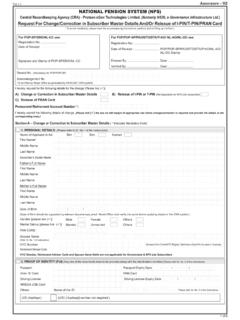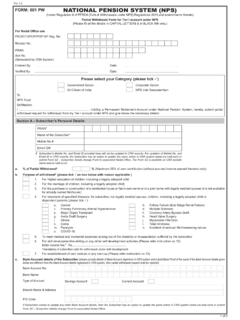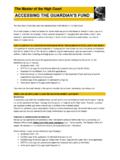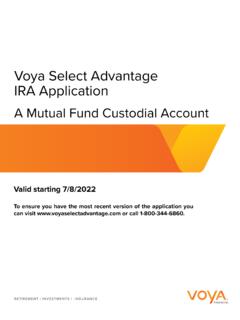Transcription of FREQUENTLY ASKED QUESTIONS (FAQ)
1 1) What is National Pension System? NPS is an easily accessible, low cost, tax-efficient, flexible and portable retirement savings account. Under the NPS, the individual contributes to his retirement account and also his employer can also co-contribute for the social security/welfare of the individual. NPS is designed on Defined contribution basis wherein the subscriber contributes to his account, there is no defined benefit that would be available at the time of exit from the system and the accumulated wealth depends on the contributions made and the income generated from investment of such wealth. The greater the value of the contributions made, the greater the investments achieved, the longer the term over which the fund accumulates and the lower the charges deducted, the larger would be the eventual benefit of the accumulated pension wealth likely to be. 2) Who is the regulator for NPS? PFRDA is the regulator for NPS.
2 Pension fund Regulatory and Development Authority (PFRDA) is an Authority set up by the Government of India through the PFRDA Act 2013 to promote old age income security by establishing, regulating and developing pension funds to protect the interest of subscribers to schemes of pension funds and for matters connected therewith or incidental thereto. 3) Can an NRI open an NPS account? Yes, a NRI can open an NPS account. Contributions made by NRI are subject to regulatory requirements as prescribed by RBI and FEMA from time to time. If the subscriber's citizenship status changes, his/ her NPS account would be closed. 4) If a subscriber have invested in any other Provident fund , can I still invest in NPS? Yes. Investment in NPS is independent of subscribers contribution to any Provident fund . 5) Can a subscriber having investment in pension funds of non-government / private entities invest in NPS? Yes. Investment in NPS is independent of subscription to any other pension fund .
3 FREQUENTLY ASKED QUESTIONS (FAQ) Under National Pension System (NPS) 6) What are the tax benefits of NPS? The various Tax benefit as under: A. Employee Contribution: Deduction upto 10% of salary (basic+ DA) within overall ceiling Lakh u/s 80C. B. Voluntary Contribution: Deduction upto ,000 u/s 80 CCD(1B) from taxable income for additional contribution to NPS. C. Employer Contribution: Deduction upto 10% of salary (Basic + DA) from taxable income u/s 80 CCD(2). This is over and above the limits u/s 80C. 7) Which document can a Subscriber use as investment proof in order to avail the tax benefit? The print out of the Transaction Statement could be used as a document for claiming tax benefit. 8) Can a subscriber get loan under NPS? No. At present, a subscriber cannot avail a loan against his / her NPS holdings. 9) How can a subscriber check the status of his/her PRAN application? Subscriber can check the status by accessing CRA website: by using the 17 digit receipt number provided by POP-SP or the acknowledgement number allotted by CRA-FC at the time of submission of application forms by Nodal Offices.
4 Once the PRAN is generated, an email alert as well as a SMS alert will be sent to the registered email ID and mobile number of the subscriber. 10) Whom to contact for non-receipt of PRAN Card? PRAN Card is despatched to the nodal offices within 20 days from the day of receipt of duly filled registration form at the CRA-FC office. In case of non-receipt of the PRAN Card, a Subscriber can check with the associated nodal office or he can check the status by accessing the link: 11) What are the different options in the IVR available to the subscribers? Subscribers have the following options in IVR: a) Change of T-PIN. b) Check scheme preference and holding details. c) Check the status of any change request (like change of address, nomination etc.). d) Check details of last contribution credit and last withdrawal request (for Tier II only). e) Request for SOT for any financial year f) Check status of Subscriber Shifting g) Speak to a customer service executive 12) What is the procedure for registration of Subscribers in the CRA system for Tier II account?
5 If the Subscriber is an existing PRAN Card holder, he/she can activate the Tier II account by approaching his Nodal Office, or can contact the POPs to activate Tier II. The list of POPs is available on our website ( ). Tier II can also activate their Tier II account through eNPS ( ). 13) What are the different fund Management Schemes available to the subscriber? The NPS offers two approaches to invest subscriber s money: a) Active choice Here the individual would decide on the asset classes in which the contributed funds are to be invested and their percentages (Asset class E(maximum of 50%), Asset Class C, and Asset Class G ) b) Auto choice - Lifecycle fund - This is the default option under NPS and wherein the management of investment of funds is done automatically based on the age profile of the subscriber. For full details, one may go through our website wherein the full details of the investment choices and fund management details are provided.
6 Currently, these options are available to Government subscribers only Tier II account. 14) What is rebalancing as per regulatory requirement appearing in Transaction Statement for NPS? As mentioned in the offer document of PFRDA, in case of subscribers who have opted 'Auto choice' investment option, the percentage of investment in the asset classes E/C/G will change as per the age of the subscriber as given in the 'Life cycle Investment Matrix'. The change happens on the date of birth of the subscriber. In this process, asset allocation ratio is changed and the existing assets are redeemed and reinvested as per the new ratio of allocation. 15) How can a Subscriber change his/her scheme preference? Scheme Preference change option is not available to Government subscribers for Tier I. whereas the non-government subscribers can change it once a financial year. The Subscriber has to submit the physical application form (Form-UOS-S3) to change Scheme Preference.
7 However, such changes can be done online as well by the subscriber using the IPIN. 16) How are the returns calculated in NPS? Is there any assured return / dividend / bonus? For Central Government employees mandatorily covered under NPS, the total contribution uploaded in an employee's Tier I account is divided among three PFMs. viz. SBI Pension Funds Private Limited, UTI Retirement Solutions Limited and LIC Pension fund Limited in a predefined ratio and units are allotted in the subscribers account. For State Government employees mandatorily covered under NPS, the total contribution uploaded in an employee's Tier I account is divided among the three PFMs. viz. SBI Pension Funds Private Limited, UTI Retirement Solutions Limited and LIC Pension fund Limited in a ratio as decided by the State Government and units are allotted in the subscribers account accordingly. The PFMs invest the money in different financial instruments within the investment guidelines laid down by PFRDA and declare Net Asset Value (NAV) at the end of each business day.
8 Accordingly, based on the NAV, units are credited in the subscriber's account. The present value of the investment is arrived by the units held multiplied by the NAV. The return under NPS is market driven. Hence, there is no guaranteed/defined amount of return. The returns generated through investments are accumulated and is not distributed as dividend or bonus. 17) What are the Assets permitted for NPS funds Investment? a) Asset class E: "High return, High risk" (equity market instruments). b) Asset class G: "Low return, Low risk" fixed income instruments. The best example of this is central government bonds. c) Asset class C: "Medium return for credit risk" bearing fixed income instruments. Examples of these are bonds issued by firms. 18) What is Net Asset Value (NAV)? Also known as NAV, this is the price of one unit of a fund . NAV is calculated at the end of every working day between Monday and Friday. It is calculated by adding up the value of all the securities and cash in the fund 's portfolio (its assets), subtracting the fund 's liabilities, and dividing that number by the number of units that the fund has issued.
9 The NAV increases (or decreases) when the value of the fund 's holdings increase (or decrease). NAV of different PFMs may differ. Even the different schemes under the same PFM will have different NAV. 19) When will the units be credited to my NPS account? Subscriber's associated nodal office will upload his / her monthly contribution details to CRA along with transfer of funds to the Trustee bank appointed by PFRDA. CRA will match the contribution details uploaded by the Nodal Office with the amount confirmed by Trustee Bank and instruct the Pension fund Managers to invest the contribution as per the scheme preference. The units created will be credited by CRA to the Permanent Retirement account. 20) Will the Subscriber get any Annual Account Statement for his/her PRAN? The Annual Account Statement as of March 31st of every year will be sent to the registered correspondence address. Also, if a subscriber wishes to have a transaction statement on an adhoc basis, he/she can log into CRA system using the I-PIN and view the Transaction Statement.
10 Subscriber can also access the account details through the IVR or by getting in touch with their Nodal Offices to get a copy of the Account Statement. 21) What are the details of the Subscriber a Nodal office can update? Nodal Office can update the following requests of the employee/subscriber 1. Change in Personal details including Bank details; 2. Change in Employment details; 3. Change in Nomination details; 4. Reissue / authorize reset of I-PIN and T-PIN request; 5. Reprint of PRAN Card. Nodal office can also generate and print Transaction Statement and Statement of Holding for an employee associated with it. 22) Can a Subscriber reset the I-PIN (Internet Password) online? Yes, the Subscriber has an option to reset his/her I-PIN online. The request needs to be initiated online in CRA system by clicking on the "Forgot Password" link and selecting the "Instant Reset I-PIN". The Subscriber needs to print the acknowledgement and handover the same to the nearby PAOs/CDDOs/DTOs/POP-SPs for authorization irrespective of whether the Subscriber is associated with it or not.












